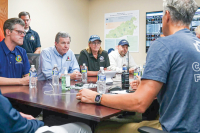Gov. Cooper offers update on Helene rescue, recovery efforts
 Gov. Roy Cooper
Gov. Roy Cooper
Gov. Roy Cooper provided an update on the emergency response and recovery from Hurricane Helene in Western North Carolina.
He began by noting the approval of a major disaster declaration for 25 North Carolina counties, as well as the Eastern Band of Cherokee Indians.
“This decision will immediately pave the way for assistance to help hard-hit local governments and provide much needed relief for residents,” he said, adding that details are forthcoming on how residents can access aid.
The storm, which dumped between 10 and 29 inches of rain across the mountains has now led to 11 confirmed deaths, a number that is likely to increase significantly over the coming days.
There are still rescue operations ongoing across the region as some areas are still submerged, and even about an hour before Cooper spoke, emergency personnel responded to a mudslide in Maggie Valley with two people entrapped in their home awaiting rescue.
At this time, aviation resources have been deployed to rescue people who are still inaccessible by emergency responders due to those water levels or landslides. In addition, as the recovery effort gains steam, other aviation resources are being used to bring in loads of supplies — such as food, water and medicine — to areas that vehicles can’t reach. With that in mind, people are asked to not fly any drones in any disaster-impacted areas because they can jeopardize those aviation operations.
Related Items
Most supplies are going to the Asheville area, after which they are being airlifted to counties west of Buncombe. As of now, 34,000 pounds of emergency supplies have been delivered.
“This is an unprecedented tragedy that requires and unprecedented response,” he said.
Most people across the region have been without cell phone or internet service since Friday morning, and only over the last 12 hours or so have some regained service. Cooper said he’s working on getting more stable infrastructure restored.
“Restoring communications is critical to saving lives and finding out where people are and getting in supplies … I’ve been in constant contact with cell phone companies,” he said.
At the time, disaster roaming is also enabled, meaning people can access any mobile network that may provide service regardless of their carrier.
As most people in Western North Carolina know, it’s hard to access most areas, especially from one county to another, as 280 state roadways are closed. For example, I-40 is entirely shut down in areas where the road has been washed away. Reports indicate the entire roadway is washed away around Mile Marker 3 in Haywood County near the Tennessee state line.
The message is that people should still consider that all roads in the region are still closed and that those wanting to travel to the region — even to check on friends, family or property — should stay out for now while the recovery effort begins.
NCDOT Secretary Joey Hopkins said some of these major repairs, such as what is needed on I-40 in Haywood County, will require “significant rebuilds.”
“Even though it’s a top priority, it will take a long time to fix that,” he said. “We’re talking months at best.”
Finally, Cooper outlined resources for those in need of aid and those looking to donate.
People wanting to see what shelters or resources are available can either call 211, visit readync.gov or visit ncdps.gov/Helene. Anyone looking to volunteer can explore opportunities at ncvoad.org/volunteer. Anyone looking to donate money can visit nc.gov/donate.













